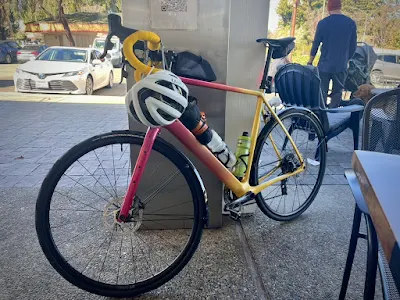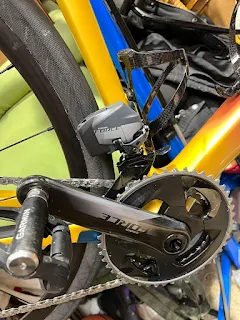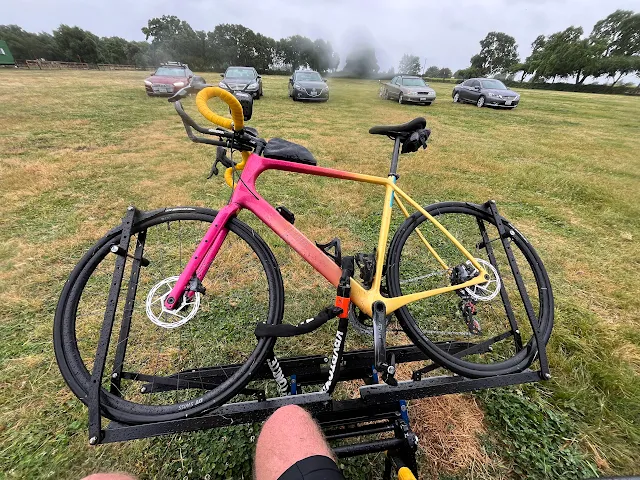 |
| As first built in winter guise with fenders |
Carbon fiber endurance road bike with 2x12 SRAM Force AXS
One of the things about getting to ride a bunch of very different bikes of different eras is you start to get an idea of what improvements have evolved over the years. In particular, the idea that a 'road bike' doesn't have to be a 'race bike' to still be sporty.
This is where the current idea of an 'endurance bike' comes in. It is a bike that is designed to be nimble, light and fast, while having a slightly more upright and comfort-oriented position. Oh, and in the 2020s, accept wider tires. Wait, wide tires? Aren't they slow? Well... it turns out not so much. A bit wider, run at correspondingly lower pressures, they ride both more comfortably and actually faster in the real world (where roads are not smooth and hysteresis takes away energy). So a nimble, fast setup that is also comfortable on long rides. Winner concept. And not in my inventory.
All my road bikes were old-school. Low 'stack' (low front end) requiring something like a 17-degree stem to get bars to a comfortable position (see the Klein or Litespeed). They also have narrow tire clearance allowing for at most 28mm tires (and really tight with those). Also zero room for fenders for winter, wet riding.
So, to solve this, I set out to find a vintage solution. I was looking for an old steel-frame 'touring' bike which has similar characteristics to today's 'endurance' bikes while being old and thus generally less expensive. But while looking, I ran into this very blingy looking frame for a great price (20% of new at only 3ish yrs old): A 2020 Salsa Warroad. Not only did it look nice, but it was actually designed with exactly what I was looking for by the team that made my gravel bike that fits so well. So, change of plans.
As a modern carbon fiber frame, it seemed appropriate to skip the vintage parts game and find modern components to build it up. Originally, I was thinking about experimenting with one of the new electronic groupsets out of China. But prices had crept up to the point where the tradeoff for new product glitches was making me uncomfortable on what would be a primary bike. Then I found a last-generation SRAM AXS set at a deep discount (closeout pricing) for only a few Euros more than the new guys somewhere in Italy (go figure, American brand, made in Asia, imported from Italy. Thanks Internet!). We're off to the races collecting various used and a few new parts.
- Groupset: SRAM Force eTap AXS HRD 2x12 Disc. Twelve-speed (rear cassette cogs), electronic shifting, hydraulic disc braking configuration. My first electronic shifting setup. As much as I love vintage shifting (even back to pre-indexed stuff), it is really really impressive how well it works. I now understand why it is so popular. As prices come down, it's going to become the norm for enthusiast level and above. The modern SRAM configuration of 46/33 chainrings combined with a 10-36t (on the wide version I got) yields a remarkably wide range of gearing for climbing hills and flying along on country roads.
Wheels: DT Swiss R470 originally. Reasonably light, barely used aluminum takeoffs (such a great way to pick up value wheels). Not quite the aero bling setup but nice enough looking and performing. I later found some carbon Reynolds ATR 40mm (aero depth) wheels that got the right look and sound along with saving a few grams.
Reynolds ATR 40mm - Tires: Continental Grand Prix 5000 S TR 700x32. GP5000s are the go-to recommendation from an amazing number of people. They test with really low rolling resistance yet adequate puncture resistance. Set up tubeless with sealant they should be quite reliable. (So far so good. A couple of punctures this summer including a roofing nail and the worst stop was putting in a Dynaplug and pumping it back up)
The frame could fit 700x35 (or 650b x 47 - that's gravel bike widths) but not with fenders which I wanted. 32mm is still tighter than official spec for the fenders but I found someone on a Facebook group who had made them work successfully with: - Fenders: SKS Bluemels Basic. I was tired of coming back from winter rides with a mud stripe up my jersey and muddy socks. They came off in mid April since the rain goes away here for a half year.
- Fit Kit:
- Bars: Ritchey Streem WCS Alloy Road 44cm. These were actually a fortuitous accident. The 3T bars I first ordered (based on the Klein and Litespeed successes) vanished in shipment somewhere. Slightly aero with flattish tops.
Stem: I had trouble with this one. The frame has relatively long 'reach' already so the 110mm one that came with the frame was going to be too long for my fit. Math on the geometry said an 80mm would match what I know fits me on other bikes. But the labeled 80mm Salsa I found ended up actually measuring 70mm and was simply too short. It made for skittish handling. Eventually, I found a 90mm / 6 degree Zipp Service Course Stem that split the difference nicely which seems to be the real goldilocks answer. Amazing to learn what a difference a couple of cm makes.Final choice 2nd from the left - Saddle: Another adventure of finding what works. So many people speak so highly of the Selle Italia Boost SLR family of saddles that when I saw a cheap Ti railed takeoff locally I had to give it a try. It looks great. Super light. But just didn't fit my behind right after an hour or so. I also tried an Ali Express / Ryet 3D printed (today's hot stuff) clone that was also close but not right. But I eventually decided to move the Sella Italia to the Litespeed (since it has Ti rails and is fine for the shorter rides I use that bike for) and bring over the tried and true WTB Volt from there. There is something to be said for sticking with what works.
- Seatpost: The frame came with a carbon Salsa Guide post. This was my first experience riding on a carbon post and it kinda freaked me out at first. Unlike the stiff aluminum ones I've always ridden, carbon posts are designed to flex under you for compliance. The subtle movement feels strange at first. But once I got used to it, the compliance is really nice.
Misc: Since this is a Salsa, they included lots of bolt-on spots like on a gravel bike even though it is a road bike. So I used that to add a Tailfin top tube bag which I've found is perfect for stashing glasses (important for us blind people making do with non-Rx riding glasses) and phone. Also two CF bottle cages. But since there is a third pair of bolts inside the frame (and another under), I also put a subtle Tailfin Mini Cage there. This is great because you don't really notice it but provides a place to strap on a jacket, bag of food, third bottle, etc. when needed.
Jacket strapped to Mini Cage
Irony strikes
 |
| Salsa Force AXS 700 build |
Weights
While this bike was not built to optimize weight, it ended up being nicely light for an XL frame bike (yes, frame size matters. All the official weights everyone drools over are for mid-sized frames at the most. XL frames often add as much as a kg)
- Frame: 2.47 kg (5.45 lbs)
- Full build: 9.38 kg (20.7 lbs) without fenders or toolkit
Conclusion
But does it do what I wanted? Yes. Yes it does. Despite having to fiddle with the saddle and stem, it was clear from ride one that this was a great balance of performance and comfort. Even in the winter with the fenders on, I was setting Strava PRs right away. And the ride experience of 65psi, 32mm 'wide' tires is a real comfort and safety luxury for those of us who grew up riding 120psi 23mm tires when we could. And while I still think modern rim brakes are quite adequate, disc brakes are really nice on rainy days and for this Clydesdale when descending. Oh, and it is really fun to have a visually 'loud' bike for a change. I've gone for sophisticated and/or subtle usually. But this thing is not subtle in blaze yellow and pink fade. It draws unsolicited comments.
Lifecycle Notes
- Right after build, SRAM issued a recall for shifter anchors. Apparently, it was a problem with too much factory threadlock preventing proper application of torque. The solution is to cycle the bolts while tightening. No bolt replacement is needed. Just cycle and inspect.
- I had picked up some used Profile Designs Airstryke aero bars after Foxy's 2023 and rode them on the Klein. I wanted to try them simply to see if they were faster and added meaningful alternate body positions. Well, they do that really well. Typically, speed goes up ~1mph as soon as I go there and it's nice to get pressure off the hands and stretch the back for a bit. Vision is the only real downside and the neck crink is usually what forces me back to the hoods. I resisted moving them to the Warroad for months because I didn't want all that 'bulk' added to the speedy bike. But I put them on for the very flat Delta Century in Lodi where an aero position seemed useful. It was. So much so that I haven't taken them back off.
At the Delta Century with aero bars - Once committed to the aero bars staying on the bike, I added remote shifting blips to them which allows for shifting while in the forward position. One of the perks of electronic shifting. For efficiency context, I almost always click down at least one gear after dropping onto the aero bars because I'm faster.
- Added spider power meter after the Garmin pedal-based meter once again started to flake out on every single ride. Moved the Look Keo 2 Max Carbon pedals over instead.





Comments
Post a Comment